What is a solar panel?
Solar panel electricity systems, also known as solar photovoltaics (PV), capture the sunâs energy (photons) and convert it into electricity. PV cells are made from layers of semiconducting material, and produce an electric field across the layers when exposed to sunlight. When light reaches the cell, some of it is absorbed into the semiconducting material and causes electrons to break loose and flow. This flow of electrons is an electric current, that can be drawn out and used for powering outside devices. This current, along with the cellâs voltage (a result of built-in electric fields), define the power that the solar cell is capable of producing. It is worth mentioning that a PV cell can produce electricity without direct sunlight, but more sunshine equals more electricity.
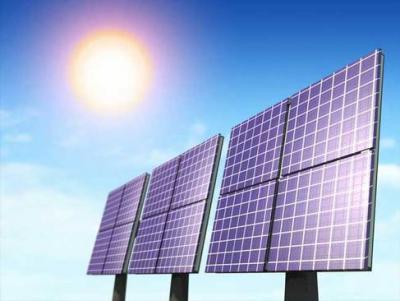
A module, or panel, is a group of cells connected electrically and packaged together. several panels can also form an array, which can provide more electricity and be used for powering larger instruments and devices.
Different kinds of Solar cells
Solar cells are roughly divided into three categories: Monocrystalline, Polycrystalline and Thin Film. Most of the worldâs PVs are based on a variation of silicon. The purity of the silicon, or the more perfectly aligned silicon molecules are, affects how good it will be at converting solar energy. Monocrystalline solar cells (Mono-Si, or single-crystal-Si) go through a process of cutting cylindrical ingots to make silicon wafers, which gives the panels their characteristic look. They have external even coloring that suggests high-purity silicon, thus having the highest efficiency rates (typically 15-20%). They are also space efficient (their efficiency allows them to be small) and live longer than other kinds of solar panels. Alas, they are more expensive than other kinds and tend to be damaged by external dirt or snow.
Polycrystalline silicon (p-Si or mc-Si) solar cells do not go through the abovementioned process, and so are simpler and cost less than Monocrystalline ones. Their typical efficiency is 13-16%, due to lower silicon purity. They are also bigger and take up more space.
Thin-Film solar cells (TFSC), are made by depositing one or several thin layers of photovoltaic material onto a substrate. Different types of TFSCs are categorized by which photovoltaic material is deposited onto the substrate: Amorphous silicon (a-Si), cadmium telluride (CdTe), copper indium gallium selenide (CIS/CIGS), polymer solar panels and organic photovoltaic cells (OPC). Thin-film modules have reached efficiencies of 7-13%. Their mass production is simple, they can be made flexible and are potentially cheaper to manufacture than crystalline-based solar cells. They do, however, take up a lot of space (hampering their use in residential applications) and tend to degrade faster than crystalline solar panels.
Solar power advantages and disadvantages
Solar power is free and infinite, and solar energy use indeed has major advantages. It is an eco-friendly, sustainable way of energy production. Solar energy systems today are also much cheaper than they were 20 years ago, and save money in electricity expenses. In addition, it is a much environmentally cleaner form of energy production that helps reduce global warming and coal pollution. It does not waste water like coal and nuclear power plants and is also considered to be a form of energy that is much safer for use.
Although solar power production is widely considered to be a positive thing, some downsides require mentioning. The initial cost of purchasing and installing solar panels can be substantial, despite widespread government subsidy programs and tax initiatives. Sun exposure is critical and so location plays a significant role in the generation of electricity. Areas that are cloudy or foggy for long periods of time will produce much less electricity. Other commonly argues disadvantages regard insufficiency of produced electricity and reliability issues.
Solar power applications
Common solar energy applications include various residential uses such as solar lighting, heating and ventilation systems. Many small appliances utilize solar energy for operation, like calculators, scales, toys and more. Agriculture and horticulture also employ solar energy for the operation of different aids like water pumps and crop drying machines. The field of transportation has been interested in solar powered vehicles for many years, including cars, planes and boats that are vigorously researched and developed. Solar energy also has various industrial applications, ranging from powering remote locations as well as space and satellite systems, to powering transportation signals, lighthouses, offshore navigation systems and many more.
Solar technologies are vigorously researched, aiming to lower costs and improve existing products as well as integrate PV systems in innovative products like PV-powered curtains, clothes and laptop cases.
Graphene and solar panels
Graphene is made of a single layer of carbon atoms that are bonded together in a repeating pattern of hexagons. It is a 2 dimensional material with amazing characteristics, which grant it the title âwonder materialâ. It is extremely strong and almost entirely transparent and also astonishingly conductive and flexible. Graphene is made of carbon, which is abundant, and can be a relatively inexpensive material. Graphene has a seemingly endless potential for improving existing products as well as inspiring new ones.
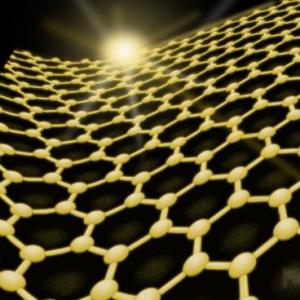
Solar cells require materials that are conductive and allow light to get through, thus benefiting from graphene's superb conductivity and transparency. Graphene is indeed a great conductor, but it is not very good at collecting the electrical current produced inside the solar cell. Hence, researchers are looking for appropriate ways to modify graphene for this purpose. Graphene Oxide (GO), for example, is less conductive but more transparent and a better charge collector which can be useful for solar panels.
The conductive Indium Tin Oxide (ITO) is used with a non-conductive glass layer as the transparent electrodes in most organic solar panels to achieve these goals, but ITO is rare, brittle and makes solar panels expensive. Many researches focus on graphene as a replacement for ITO in transparent electrodes of OPVs. Others search for ways of utilizing graphene in improving overall performance of photovoltaic devices, mainly OPVs, as well as in electrodes, active layers, interfacial layers and electron acceptors.
Commercialization efforts
While graphene-based solar cells are not currently commercially available, some efforts are bearing fruit in regards to the use of graphene in auxiliary aspects of PV. One such example is ZNShine Solar's G12 evolution era series - comprised of a 12-busbar graphene module, 5-busbar graphene module and double-glass graphene module. According to reports, the application of ZS's graphene film layer increases light transmission performance of the glass itself. In addition, Znshine Solar's modules are self-cleaning. In July 2018, ZNShine Solar won the bid to provide 37.5MW of PV modules to Bharat Heavy Electricals Limited (BHEL), India's largest power generation equipment manufacturer. According to the contract, 10% of the shipment will be graphene-coated solar panels. In June 2019, Znshine Solar announced signing a 100MW graphene-enhanced solar module supply agreement with UAE's Etihad Energy services.
Further reading
The latest graphene solar news:
Thin graphene film quickly warms up to super high temperatures
A collaboration between three Australian universities has produced a new graphene metamaterial that could be used in solar heating. The ultrathin film also has potential to be used in desalination, for displays, or even as cloaking technology.

Swinburne University of Technology’s Professor Baohua Jia, who led the research, points to a few features that make the material so innovative: The absorption is coming from the sun and then converted to heat, she said, So, basically, there is no external energy or electricity required. The film heats up to 160 degrees Celsius under natural sunlight within one minute.
Verditek raises over $730,000 for solar cell commercialization
Verditek, developer of lightweight solar panels along with Paragraf, a Cambridge-based graphene technology developer, announced that it has raised GBP 600,000 (around USD 739,500/EUR 676,400) in a share placing to speed up its growth plans, replenish working capital and fund a silicon/graphene solar project.
The company said it will use the raised funds to speed up its growth plans as it moves to commercialization, provide working capital for its Italian solar factory, which can currently produce 20 MW of modules per year, and cover its 50% share of the joint development programme with Paragraf, under which the two are working on a silicon/graphene integrated solar cell.
Korean scientists develop graphene electrode to enable next-gen perovskite solar cells
Several research institutions in South Korea are actively conducting research and development on next-generation solar cells, heightening expectations for commercialization. The research team led by Prof. Yoon Soon-gil of Chungnam National University has developed a new graphene electrode to produce perovskite solar cells at a low temperature. In addition, the team led by Prof. Choi Kyoung-jin of the School of Materials Science and Engineering at UNIST has developed a new concept tandem solar cell using transparent conductive adhesives (TCA).
The graphene electrode developed by Professor Yoon’s team can help create a perovskite solar cell at a low temperature and can raise both safety and economic efficiency.
Elcora enters R&D agreement with Solargise Canada for graphene-enhanced solar technology
 Elcora Advanced Materials has announced it has entered into a research and development agreement with Solargise Canada, a solar manufacturing and utility-scale power project development company.
Elcora Advanced Materials has announced it has entered into a research and development agreement with Solargise Canada, a solar manufacturing and utility-scale power project development company.
The scope of work of the research and development agreement includes the development of new technologies using graphite and graphene to improve and augment the efficiency of the solar photovoltaic panels manufactured by Solargise.
Verditek and Paragraf shooting for high efficiency silicon/graphene solar cells
Verditek and Paragraf have announced that they have successfully applied graphene to a photovoltaic (PV) cell as part of a joint development program (JDR) and are now continuing work with the goal of surpassing 25% efficiency.
London-based clean technology company Verditek explains that as part of the partners’ first development project they applied Paragraf's graphene manufacturing process to Verditek's solar technology to produce a working proof-of-concept silicon/graphene integrated solar cell. As a next-stage project, they will aim to boost the performance of the cells, develop the opportunity to file patents and possibly initiate commercial discussions for industrial manufacture and application.
ZNShine to supply graphene-enhanced solar modules to the UAE
Znshine Solar, a Chinese solar module manufacturer, has announced signing a 100MW graphene-enhanced solar module supply agreement with UAE's Etihad Energy services as a result of Znshine's participation in the tender launched by DEWA (Dubai Electricity and Water Authority) in January.
CEO of Etihad Energy Services, Mr. Ali Mohammed Al Jassim, explained that the modules will be used in various projects as part of Shams Dubai, the leading initiative that supports the vision of the government to make Dubai one of the most sustainable cities in the world; it also supports diversifying the energy mix by promoting the use of clean and renewable energy sources to build a sustainable future for the Emirate.
Graphene inks help stabilize the stability of perovskite solar cells
Researchers from the Graphene Flagship have developed hybrids of graphene and molybdenum disulphide quantum dots to stabilize perovskite solar cells (PSCs). PSCs are a novel type of solar cells which are efficient, relatively easy to produce, made with cheaper materials and, due to their flexibility, can be used in locations where traditional silicon solar cells cannot be placed.
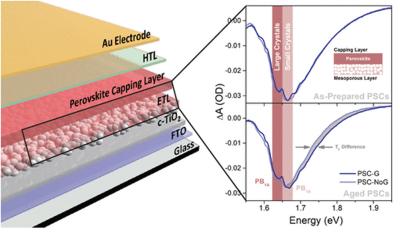
A collaboration between the Graphene Flagship Partners Istituto Italiano di Technologia, University of Rome Tor Vergata, and BeDimensional resulted in a novel approach based on graphene and related materials to stabilize PSCs, thus addressing the stability issue of PSCs, a major hurdle hindering their commercialization.
The Graphene Flagship announces its 2019-2030 graphene application roadmap
The EU Graphene Flagship has published its graphene application roadmap, showing when the flagship expects different graphene applications to mature and enter the market.
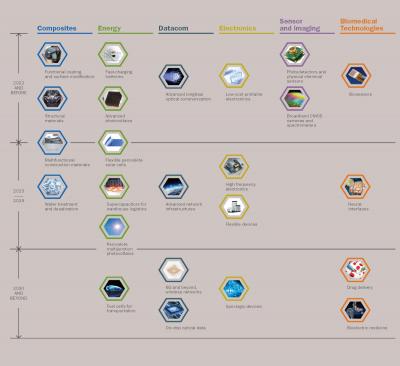 As can be seen in the roadmap above (click here for a larger image), the first applications that are being commercialized now are applications such as composite functional coatings, graphene batteries, low-cost printable electronics (based on graphene inks), photodetectors and biosensors.
As can be seen in the roadmap above (click here for a larger image), the first applications that are being commercialized now are applications such as composite functional coatings, graphene batteries, low-cost printable electronics (based on graphene inks), photodetectors and biosensors.
Novel graphene film offers new concept for solar energy
Researchers at Swinburne, the University of Sydney and Australian National University have collaborated to develop a solar absorbing, ultra-thin graphene-based film with unique properties that has great potential for use in solar thermal energy harvesting.
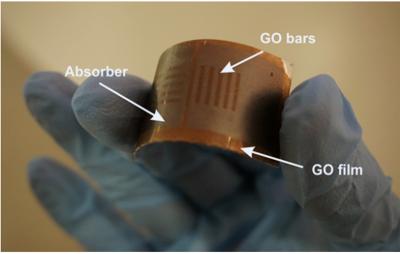
The 90 nanometre material is said to be a 1000 times finer than a human hair and is able to rapidly heat up to 160°C under natural sunlight in an open environment.
Graphene-enhanced E-skin generates and stores electricity for prosthetic devices
Researchers at the University of Glasgow in Scotland have developed an electronic skin that can generate and store electricity for prosthetic devices.
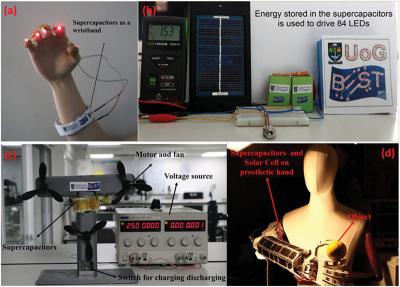
The technology consists of layers of a finely tuned graphite-polyurethane composite covered by graphene. The team explained that the graphite-polyurethane works as an electric supercapacitor, storing energy that can be used at any time by a prosthetic. The graphene component is said to essentially be a solar panel that converts sunlight to electricity to charge the supercapacitor.
Pagination
- Previous page
- Page 3
- Next page